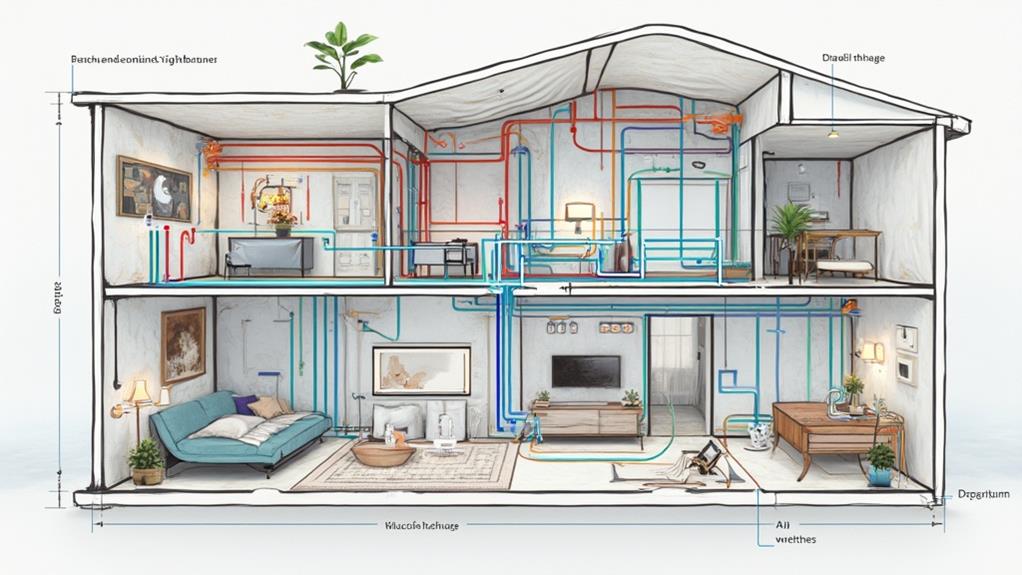Planning for home automation requires a comprehensive assessment of your existing electrical system and network infrastructure. Key considerations include evaluating panel capacity, examining wiring age, and identifying areas for additional power points or ethernet ports. Implementing robust network connectivity with Cat6 cabling and mesh Wi-Fi systems is crucial for reliable performance. Smart home hub placement should be optimized for consistent coverage, while automated lighting and security systems require careful wiring planning. Future-proofing your infrastructure involves installing conduit, using high-quality cabling, and designing for scalability. By addressing these factors, you'll create a solid foundation for a seamlessly integrated smart home ecosystem. The following sections explore these considerations in greater detail.
Assessing Your Home's Electrical System
When embarking on a home automation project, the first crucial step is evaluating your home's electrical system. This assessment determines whether your current infrastructure can support the additional devices and technologies you plan to implement. Begin by examining your electrical panel's capacity and the age of your wiring. Older homes may require upgrades to handle the increased load of smart devices.
Next, conduct a thorough inventory of existing outlets, switches, and fixtures. Identify areas where additional power points or ethernet ports may be necessary to accommodate new smart home components. Consider the placement of sensors, cameras, and control panels, ensuring adequate power supply and network connectivity.
Assess your home's Wi-Fi coverage and signal strength, as many smart devices rely on a robust wireless network. Determine if you need to install additional access points or a mesh network system to ensure seamless connectivity throughout your home.
Network Connectivity Requirements
Invariably, a robust network infrastructure forms the backbone of any successful home automation system. To ensure seamless connectivity for your smart devices, consider both wired and wireless solutions.
Ethernet cabling remains the most reliable option for high-bandwidth applications and devices that require consistent performance. Cat6 or Cat6a cables are recommended for future-proofing your network.
For wireless connectivity, a robust Wi-Fi network is essential. Implement a mesh Wi-Fi system to eliminate dead zones and provide consistent coverage throughout your home. Consider Wi-Fi 6 (802.11ax) routers and access points for improved performance and device handling capacity.
Some home automation protocols, such as Z-Wave and Zigbee, require dedicated hubs or controllers. Plan for centralized locations to install these devices, ensuring optimal signal propagation. For larger homes, multiple hubs or signal repeaters may be necessary.
Power over Ethernet (PoE) can simplify installation for devices like security cameras and smart switches. Install PoE-capable network switches or injectors to support these devices.
Lastly, consider network segmentation and VLANs to isolate IoT devices from your main network, enhancing security and performance. Implement a robust firewall and keep all devices updated to maintain a secure smart home environment.
Smart Home Hub Placement
The strategic placement of smart home hubs is a key factor in optimizing the performance of your home automation system. When determining the ideal location for your hub, consider central positioning within the home to ensure consistent connectivity with all smart devices. Avoid placing the hub near large metal objects, concrete walls, or other potential sources of interference that could disrupt wireless signals.
For multi-story homes, situate the hub on the middle floor to maximize coverage throughout the house. If possible, elevate the hub by placing it on a shelf or mounting it on a wall to improve signal propagation. Keep the hub away from other electronic devices that may cause interference, such as microwaves, cordless phones, or baby monitors.
Ensure adequate ventilation around the hub to prevent overheating, which can impact performance. If your home has a complex layout or thick walls, consider using mesh network systems or range extenders to supplement the hub's coverage. For homes with multiple hubs, strategically distribute them to create overlapping coverage zones, enhancing overall system reliability and responsiveness. Regularly test and adjust hub placement as needed to maintain optimal performance as your smart home ecosystem evolves.
Wiring for Automated Lighting
Proper wiring forms the backbone of an effective automated lighting system. When planning for automated lighting, consider both new construction and retrofitting existing homes. For new builds, install neutral wires in all switch boxes to support smart switches and dimmers. In older homes, evaluate existing wiring and plan for upgrades where necessary.
Use low-voltage wiring for LED lighting systems, which offer energy efficiency and flexibility. Install CAT6 Ethernet cables to key locations for networked lighting controls. Consider power-line communication (PLC) systems that use existing electrical wiring for data transmission, reducing the need for additional cabling.
For outdoor lighting automation, use weather-resistant wiring and junction boxes. Plan for future expansion by installing conduits and extra wiring capacity. Implement a centralized lighting control panel for easier management and troubleshooting.
Ensure compliance with local electrical codes and consider hiring a licensed electrician for complex installations. Label all wires and create detailed documentation of the lighting infrastructure. This will facilitate future maintenance and upgrades. By carefully planning the wiring infrastructure, you'll create a robust foundation for a reliable and scalable automated lighting system.
Planning for Security Systems
While automated lighting enhances comfort and efficiency, a comprehensive home automation system often includes robust security features. Planning for security systems requires careful consideration of wiring and infrastructure needs.
Begin by determining the locations for security cameras, motion sensors, door and window contacts, and control panels. These elements form the backbone of your security network.
For cameras, plan for both power and data connections. Power over Ethernet (PoE) cables can serve both purposes, simplifying installation. Ensure adequate coverage of entry points and vulnerable areas.
Motion sensors typically require low-voltage wiring, strategically placed to detect movement in key areas. Door and window contacts need wiring to each access point, connecting back to the central control panel.
Consider future expansion when planning your security infrastructure. Install conduit or leave access points for additional wiring later. Include backup power sources for critical security components to maintain protection during outages.
Integrate your security system with other home automation features for a cohesive, responsive setup. Finally, plan for secure, remote access to your system, allowing you to monitor and control your home's security from anywhere.
Future-Proofing Your Infrastructure
Future-proofing your home automation infrastructure is essential to ensure your system remains adaptable and efficient as technology evolves. Consider installing conduit or cable raceways throughout your home, allowing for easy cable upgrades or replacements without invasive construction. Opt for structured wiring with centralized distribution panels, which provide flexibility for adding or modifying connections.
Implement a robust network backbone using Cat6a or fiber optic cabling to support high-bandwidth applications and future-proof data transmission capabilities. Include multiple ethernet ports in each room and strategically place Wi-Fi access points for comprehensive coverage. Plan for expandability by allocating space in your central hub for additional equipment and leaving spare capacity in your electrical panels.
Consider emerging technologies like Power over Ethernet (PoE) and integrate them into your infrastructure design. Invest in open-standard protocols and platforms that support interoperability between different devices and manufacturers. Finally, document your infrastructure thoroughly, including cable routes, port assignments, and system configurations, to facilitate future maintenance and upgrades. By implementing these strategies, you'll create a flexible foundation that can accommodate technological advancements and changing needs for years to come.
Frequently Asked Questions
How Much Does a Typical Home Automation System Cost to Install?
The cost of a typical home automation system installation varies widely, ranging from $2,000 to $20,000 or more. Factors influencing price include the size of the home, desired features, and complexity of the system chosen.
Can I Install a Home Automation System in a Rented Property?
Installing a home automation system in a rented property is possible, but with limitations. Opt for non-invasive, wireless solutions that don't require permanent modifications. Always consult your landlord and review lease agreements before making any changes to the property.
Are There Any Health Concerns Associated With Home Automation Technologies?
Home automation technologies generally pose minimal health risks. Some concerns include EMF exposure from wireless devices and potential cybersecurity vulnerabilities. However, when used responsibly and following manufacturer guidelines, these systems are considered safe for household use.
How Can I Ensure My Home Automation System Is Compatible With Voice Assistants?
Wondering if your smart home will respond to your voice? The key lies in careful selection. Choose devices and hubs that explicitly support popular voice assistants like Alexa, Google Assistant, or Siri. Ensure compatibility across your ecosystem for seamless integration.
What Are the Energy-Saving Benefits of Implementing a Home Automation System?
Home automation systems offer significant energy-saving benefits through smart thermostats, automated lighting control, and appliance management. These features optimize energy usage by adjusting settings based on occupancy, schedules, and real-time data, leading to reduced consumption and lower utility bills.
Conclusion
Proper planning proves paramount when prepping a property for pervasive home automation. Meticulous management of myriad considerations—from electrical evaluations to network necessities—ensures efficacious implementation. Strategically situating smart hubs, selecting suitable security systems, and carefully configuring connectivity create a cohesive, cutting-edge living space. Wiring wisdom and forward-thinking infrastructure foster flexibility for future functionality. By balancing current requirements with coming innovations, homeowners harmoniously harness the benefits of burgeoning smart home technologies, creating comfortable, connected, and controllable domestic domains.

